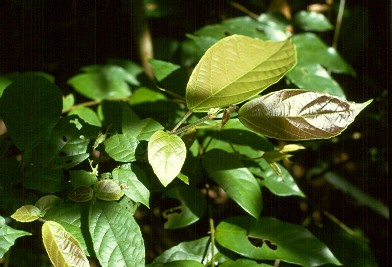Mallotus dispar (Blume) Műll.Arg.
Small trees up to ca. 15 m tall and 20 cm dbh, reproductive from 2 m tall and 2 cm dbh. Twigs solid, densely hairy (short simple, tufted and stellate hairs). Stipules triangular, semi-persistent, erect, 2-8 mm long by 0.5-2 mm wide. Petioles densely hairy, petioles of opposite leave pairs differing in length, petiole of large leaf up to ca. 4.5 cm long, petiole of opposite small leaf up to ca. 0.5 cm long. Leaves opposite, one of each pair much smaller, either of similar shape as large leaf, or of different, more rounded shape; large leaf ovate to obovate, 11-22 cm long by 4-8 cm wide, length/width-ratio 2.13-3.15; secondary veins 5-9, not ending in the margin (looping) to sometimes apically ending in the margin; leaf base usually slightly cordate; leaf margin with glands, apically often serrate; leaf upper surface glabrous to hairy on veins, with 2-12 basal nectary glands on tertiary veins near the margin; leaf lower surface hairy, with or without hairy domatia in axils of secondary veins, numerously to densely gland dotted. Staminate inflorescences not branched; flowers clustered per bracteole; bracteoles with entire margin. Pistillate inflorescences not branched; fruits 10-15 mm wide, 3-locular, with many short to long, curly spines.
Ecology: Collected up to ca. 900 m altitude. A relatively shade tolerant forest understorey species, with a preference for slightly disturbed sites. Common in both primary as well as secondary forests. Usually on limestone soils.
Distribution: Thailand, Indochina, Peninsular Malaysia, Sumatra, Java, Lesser Sunda Islands, Borneo, the Philippines and Sulawesi. In Borneo it has been collected in Sarawak, Sabah, East- and South-Kalimantan.

